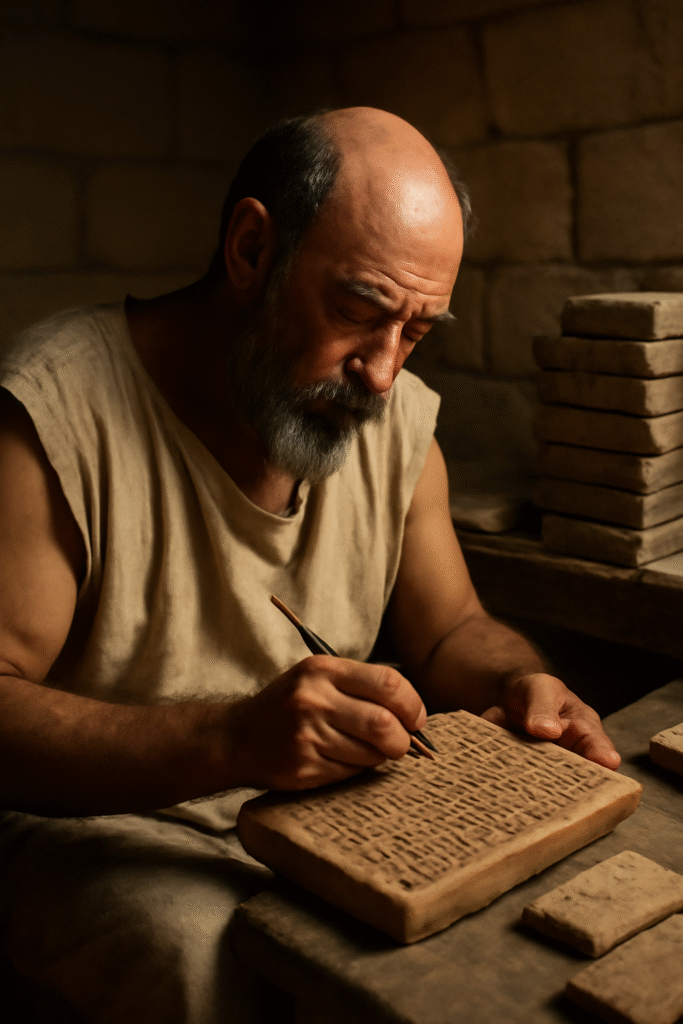Como aprendemos, registramos e compartilhamos conhecimento ao longo dos séculos.
Desde o início da humanidade, sempre fomos movidos pelo desejo de aprender, compreender e transmitir o que sabemos.
O conhecimento é muito mais do que um acúmulo de fatos — é a base da civilização, a força que impulsiona criatividade, inovação e progresso.
Mas como conseguimos preservar e transmitir o que aprendemos ao longo de milhares de anos?
Como passamos de contar histórias ao redor de uma fogueira para ter bibliotecas inteiras ao alcance das mãos?
A jornada do conhecimento humano é uma grande aventura — que se estende das paredes das cavernas às nuvens digitais.
É uma história de imaginação, resiliência e da busca incessante por melhores formas de preservar e compartilhar sabedoria.
Vamos viajar no tempo para entender como a compreensão humana chegou até o que é hoje.
As Raízes do Conhecimento: Voz, Memória e os Primeiros Registros
No começo, as pessoas aprendiam conversando, ouvindo e lembrando.
Histórias de caça, lições de vida e tradições espirituais eram transmitidas por músicas, apresentações e conversas.
Nas primeiras sociedades, a memória era a própria biblioteca — e os anciãos, os guardiões vivos da sabedoria.
Era um sistema extraordinário, porém frágil. Memórias se perdiam; detalhes mudavam. E assim começou a busca por algo duradouro.
As pinturas nas paredes das cavernas, representando caçadas, rituais e a vida cotidiana, foram algumas das primeiras formas humanas de registrar ideias.
Cada símbolo gravado ou pintado era um ato de preservação — uma promessa para as gerações futuras de que algo aprendido não seria esquecido.
Você consegue imaginar a importância de uma única pintura rupestre para quem veio depois?

A Revolução da Escrita: Tábuas, Papiro e Pergaminho
A invenção da escrita transformou tudo.
Por volta de 3.500 a.C., na antiga Mesopotâmia (atual Iraque), os sumérios desenvolveram a cuneiforme, pressionando símbolos em forma de cunha em tábuas de argila úmida, que depois eram secas ou cozidas — criando registros duráveis de leis, comércio, mitos e poemas.
No Egito, por volta de 3.000 a.C., surgiu um novo suporte: o papiro — feito a partir da planta do rio Nilo. Era leve, flexível e perfeito para longos rolos cobertos de elegantes hieróglifos.
Mais tarde, gregos e romanos simplificaram a escrita através do alfabeto, tornando-a mais acessível e adaptável. Na mesma época, o pergaminho, feito de pele animal, passou a substituir o papiro — mais resistente, reutilizável e ideal para livros encadernados.
Esse período testemunhou o surgimento de grandes bibliotecas, como a lendária Biblioteca de Alexandria — verdadeiros templos do conhecimento, onde estudiosos de diferentes regiões se reuniam para estudar, traduzir e preservar a sabedoria humana.
Aqui vai uma versão mais clara e fluida:
Como a durabilidade do pergaminho transformou a forma de armazenar e valorizar o conhecimento?
A Era dos Manuscritos: Monges e Escritos
Após a queda do Império Romano, a chama do conhecimento ocidental foi mantida viva nos mosteiros.
Monges passavam a vida inteira copiando manuscritos à mão, iluminando pacientemente os textos com miniaturas e folhas de ouro.
Cada livro era um tesouro — raro, luxuoso e extremamente caro de produzir.
Por causa disso, o conhecimento tornou-se privilégio, guardado por elites religiosas e nobres.
Durante esse período, o códice (o formato de livro com páginas encadernadas) substituiu o rolo, tornando a leitura e a consulta muito mais eficientes.
Ainda assim, a disseminação do conhecimento continuava dolorosamente lenta — até que um inventor alemão mudou a história para sempre.
A Revolução de Gutenberg: A Imprensa e o Nascimento do Conhecimento de Massa

No meio do século XV, Johannes Gutenberg introduziu a impressão com tipos móveis — um sistema que permitiu, pela primeira vez na história, produzir livros em abundância.
A Bíblia de Gutenberg marcou não apenas um marco tecnológico, mas o início da alfabetização pública e de um despertar intelectual.
A prensa transformou o mundo:
Democratização do Conhecimento:
Os livros se tornaram mais acessíveis e baratos, desencadeando uma ampla sede por aprendizado.
Avanço Científico:
Descobertas passaram a circular rapidamente, permitindo que cientistas construíssem sobre o trabalho uns dos outros.
Reforma Religiosa:
Bíblias impressas deram às pessoas a possibilidade de interpretar o texto sagrado de forma independente, desafiando hierarquias religiosas.
Nascimento da Opinião Pública:
Panfletos, ensaios e periódicos deram voz às pessoas e criaram uma nova cultura de debate.
A impressão não apenas multiplicou palavras — multiplicou possibilidades.
Redefiniu educação, comunicação e, no fim, como as sociedades pensavam sobre verdade e autoridade.
Você consegue imaginar nosso mundo sem livros impressos?
O Século XX: A Mídia de Massa e o Surgimento da Mente Digital
No início do século XX, surgiram canais totalmente novos de comunicação.
O rádio levou vozes para dentro de cada lar.
A televisão combinou som e imagem para informar, educar e cativar milhões.
O cinema tornou-se, ao mesmo tempo, entretenimento e arquivo — um registro em movimento das experiências humanas.
Mas a invenção mais transformadora não veio da transmissão, e sim da computação.
O computador, inicialmente uma máquina volumosa usada para cálculos e defesa, logo se tornou um recipiente para memória.
Já no final do século, a internet conectou máquinas — e, com elas, pessoas — em uma teia global interligada.
O conhecimento do mundo deixou de estar confinado as estantes; tornou-se dinâmico, pesquisáveis e compartilhado.
A Era Digital: O Conhecimento nas Nuvens

Agora, no século XXI, o repositório humano de conhecimento flutua em redes invisíveis de dados — a nuvem.
Em vez de argila ou papel, nossos registros vivem em código binário, acessíveis a qualquer pessoa com uma tela e uma conexão.
Digitalização em Massa:
Bibliotecas, arquivos e museus digitalizaram suas coleções, tornando manuscritos antigos disponíveis para o mundo inteiro.
A Internet como Biblioteca Global:
Sites, blogs, vídeos, podcasts e redes sociais transformaram o planeta em uma grande conversa contínua.
Aprendizagem Online:
Cursos abertos e plataformas educacionais tornam o estudo possível de qualquer lugar, fortalecendo aprendizes ao longo da vida.
Colaboração Global:
Cientistas, artistas e pensadores trabalham juntos além das fronteiras, muitas vezes em tempo real.
Mas a abundância de informação também traz novos desafios.
Desinformação, bolhas digitais, privacidade de dados e a velocidade vertiginosa com que tudo circula criam dilemas éticos e cognitivos que nossos ancestrais jamais poderiam imaginar.
Como garantir que esse oceano infinito de dados permaneça confiável, significativo e verdadeiro?
Uma Jornada em Andamento
Das tábuas de argila à nuvem, a história do conhecimento é a história da própria humanidade.
Cada mudança na forma de registrar e compartilhar ideias remodelou o aprendizado, a cultura e o poder.
Cada novo método de preservar sabedoria também ampliou o que significa ser humano.
Hoje, temos em nossas mãos um nível de acesso inimaginável para qualquer geração anterior.
Mas esse acesso vem acompanhado de responsabilidade — aprender com criticidade, criar com intenção e compartilhar conhecimento com cuidado.
A evolução do conhecimento está longe de terminar.
O próximo capítulo cabe a nós escrevermos — e a caneta, ou o código, já está em suas mãos.
Qual será o avanço que poderá definir a próxima forma de registrar e transmitir a compreensão humana?
